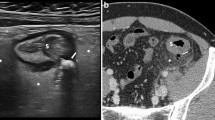Abstract
Background
The importance of inflammation markers in predicting perforation in acute sigmoid diverticulitis is not well known. Predicting perforation by clinical examination alone may be hazardous. If perforation is suspected, then appropriate diagnostic tools such as computed tomography (CT) are indicated, and surgical intervention might be necessary.
Methods
A cohort of consecutive patients with acute sigmoid diverticulitis diagnosed by CT and with complete laboratory findings (n = 247) were retrospectively divided into two groups, one with perforation (n = 86) and another without (n = 161). The latest values of C-reactive protein (CRP), white blood cell count (WBC), and serum bilirubin, as well as the activity of the alkaline phosphatase (AP) measured during the 48 h period before the CT scan, were assessed.
Results
In the Wilcoxon rank sum test CRP and WBC correlate significantly (p < 0.05) with perforation in acute sigmoid diverticulitis, whereas the logistic regression model shows only CRP to correlate significantly (p = 0.001) with perforation. The sensitivities/specificities for perforation are 98%/5% for elevated CRP (>5 mg/l), 86%/27% for a CRP higher than 50 mg/l, 44%/81% for a CRP higher than 150 mg/l, 28%/93% for a CRP higher than 200 mg/l, 88%/44% for elevated WBC (>10 × 109/l), 35%/90% for hyperbilirubinemia (>20 μmol/l), and 35%/91% for elevated AP (>110 U/l).
Conclusions
A CRP below 50 mg/l suggests a perforation to be unlikely in acute sigmoid diverticulitis, whereas a CRP higher than 200 mg/l is a strong indicator of perforation.



Similar content being viewed by others
References
Tursi A, Brandimarte G, Giorgetti G et al (2008) The clinical picture of uncomplicated versus complicated diverticulitis of the colon. Dig Dis Sci 53:2474–2479
Kaiser AM, Jiang JK, Lake JP et al (2005) The management of complicated diverticulitis and the role of computed tomography. Am J Gastroenterol 100:910–917
Gasche C, Vermeire S (2006) Laboratory tests—what do they tell us? In: Kruis W, Forbes A, Jauch KW, Kreis ME, Wexner SD (eds) Diverticular disease: emerging evidence in a common condition. Springer, New York, pp 55–66
Schentag JJ, O’Keeffe D, Marmion M et al (1984) C-reactive protein as an indicator of infection relapse in patients with abdominal sepsis. Arch Surg 119:300–304
Póvoa P, Almeida E, Moreira P et al (1998) C-reactive protein as an indicator of sepsis. Intensive Care Med 24:1052–1056
John SK, Teo NB, Forster AL (2007) A prospective study of acute admissions in a surgical unit due to diverticular disease. Dig Surg 24:186–190
Tung CB, Tung CF, Yang DY et al (2005) Extremely high levels of alkaline phosphatase in adult patients as a manifestation of bacteremia. Hepatogastroenterology 52:1347–1350
Fang MH, Ginsberg AL, Dobbins WO 3rd (1980) Marked elevation in serum alkaline phosphatase activity as a manifestation of systemic infection. Gastroenterology 78:592–597
Whitehead MW, Hainsworth I, Kingham JG (2001) The causes of obvious jaundice in South West Wales: perceptions versus reality. Gut 48:409–413
Clare A, Teubner A, Shaffer JL (2008) What information should lead to a suspicion of catheter sepsis in HPN? Clin Nutr 27:552–556
Garvin IP (1837) Remarks on pneumonia biliosa. S Med Surg J 1:536–544
Utili R, Abernathy CO, Zimmerman HJ (1976) Cholestatic effects of Escherichia coli endotoxin on the isolated perfused rat liver. Gastroenterology 70:248–253
Trauner M, Fickert P, Stauber RE (1999) Inflammation-induced cholestasis. J Gastroenterol Hepatol 14:946–959
Moradpour D (2006) Leber. In: Siegenthaler W, Blum HE (eds) Klinische pathophysiologie, 9th edn. Thieme, Stuttgart, New York, pp 859–888
Sand M, Bechara FG, Holland-Letz T et al (2009) Diagnostic value of hyperbilirubinemia as a predictive factor for appendiceal perforation in acute appendicitis. Am J Surg 198:193–198
Sellner F, Sobhian B, Baur M et al (2007) Intermittent hepatic portal vein gas complicating diverticulitis—a case report and literature review. Int J Colorectal Dis 22:1395–1399
Kircher MF, Rhea JT, Kihiczak D et al (2002) Frequency, sensitivity, and specificity of individual signs of diverticulitis on thin-section helical CT with colonic contrast material: experience with 312 cases. Am J Roentgenol 178:1313–1318
Hinchey E, Schaal P, Richards G (1978) Treatment of perforated diverticular disease of the colon. Adv Surg 12:85–109
Conflicts of interest statement
None.
Author information
Authors and Affiliations
Corresponding author
Rights and permissions
About this article
Cite this article
Käser, S.A., Fankhauser, G., Glauser, P.M. et al. Diagnostic Value of Inflammation Markers in Predicting Perforation in Acute Sigmoid Diverticulitis. World J Surg 34, 2717–2722 (2010). https://doi.org/10.1007/s00268-010-0726-7
Published:
Issue Date:
DOI: https://doi.org/10.1007/s00268-010-0726-7




